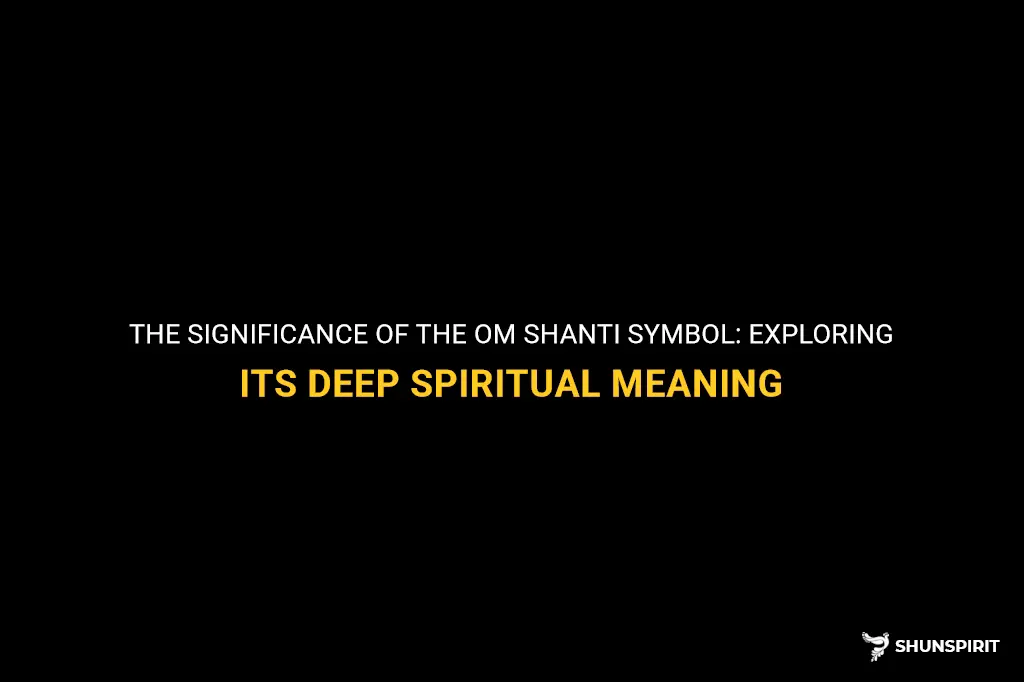
Om Shanti is a powerful symbol that is widely recognized and used in various spiritual and religious practices around the world. The symbol, which combines the Sanskrit words Om and Shanti, carries a deep and profound meaning. Om represents the universal sound or vibration of creation and is considered to be the primordial sound of the universe. Shanti translates to peace or tranquility in English. Together, the Om Shanti symbol represents the desire for inner peace, harmony, and balance in one's life. It serves as a reminder to cultivate a state of peace within oneself and to radiate that peace outwards into the world. In this article, we will explore the intricate meaning behind the Om Shanti symbol and its significance in various spiritual practices.
What You'll Learn
- What is the meaning behind the Om Shanti symbol?
- How is the Om Shanti symbol used in Hindu and Buddhist practices?
- Can you explain the significance of each individual component of the Om Shanti symbol?
- Are there variations or different interpretations of the Om Shanti symbol?
- How does the Om Shanti symbol promote peace and tranquility in one's life?

What is the meaning behind the Om Shanti symbol?
The Om Shanti symbol is a sacred symbol in Hinduism and Buddhism that represents peace, tranquility, and spiritual enlightenment. The symbol is derived from two Sanskrit words: "Om" and "Shanti".
Om is a powerful and ancient mantra that is considered the primordial sound of the universe. It is believed that the universe originated from the sound of Om, and chanting this sacred mantra can bring about a state of deep meditation and spiritual awareness. Om is often used at the beginning or end of prayers and meditation sessions to invoke a sense of peace and connection with the divine.
Shanti, on the other hand, is a Sanskrit word that means peace. It represents a state of calmness, harmony, and inner tranquility. Shanti is often used in prayers and mantras to wish for peace in the world, for oneself, and for others. It is believed that by repeating the word shanti, one can help bring about a sense of peace, both internally and externally.
When combined, the Om Shanti symbol represents the union of the primordial sound Om and the state of peace and tranquility, or shanti. It is a visual representation of the spiritual journey towards inner peace and enlightenment. The symbol is often used in meditative practices, yoga, and religious ceremonies to cultivate a sense of peace and to connect with the higher self or the divine.
The Om Shanti symbol is often depicted as a stylized version of the Om symbol with the word Shanti written below or beside it. The symbol can vary in design, with different fonts, colors, and embellishments, but the essence remains the same – to invoke a feeling of peace and spiritual harmony.
In Hindu and Buddhist traditions, chanting or meditating on the Om Shanti symbol is believed to bring about a state of deep relaxation, stress relief, and spiritual awakening. It is said to help calm the mind, release negative energy, and create a sense of oneness with the universe. The symbol serves as a reminder to let go of worries, fears, and attachments, and to embrace inner peace and serenity.
The Om Shanti symbol is not just a visual representation; it holds deep meaning and significance in the spiritual and philosophical traditions of Hinduism and Buddhism. It reminds us to seek peace, to cultivate inner stillness, and to connect with the divine essence that resides within each one of us. By embracing the Om Shanti symbol, we are reminded of our innate capacity for peace and harmony, and are inspired to embody these qualities in our thoughts, words, and actions.
Unlocking the Hidden Meanings of the Thelema Symbol
You may want to see also

How is the Om Shanti symbol used in Hindu and Buddhist practices?
The Om Shanti symbol is a sacred symbol that is used in both Hindu and Buddhist practices. It is a powerful mantra that represents peace and harmony, and is often chanted or meditated upon to achieve a state of tranquility and inner peace.
In Hinduism, the Om Shanti symbol is considered to be one of the most important mantras. The sound of "Om" is said to be the cosmic sound that created the universe, and it is believed to represent the essence of the ultimate reality or higher power. Shanti, on the other hand, means "peace" in Sanskrit. When chanted together, the mantra Om Shanti is believed to bring peace not only to the reciter but also to the entire world.
In Hindu rituals and ceremonies, the Om Shanti symbol is often recited or chanted at the beginning and end of prayers, as a way to invoke peace and bless the gathering. It is also commonly used in meditation practices, where individuals sit in a quiet and peaceful space, close their eyes, and repeat the mantra Om Shanti to calm their mind and find inner peace.
Similarly, in Buddhism, the Om Shanti symbol holds great significance. Buddhism also emphasizes the importance of inner peace and tranquility, and the Om Shanti mantra is frequently used to achieve this state. Buddhist practitioners believe that by meditating on the Om Shanti mantra, one can detach themselves from the worries and troubles of the world and find solace in the present moment.
In Buddhist temples and monasteries, the Om Shanti symbol is often displayed prominently, along with other sacred symbols and mantras. It serves as a reminder to practitioners to cultivate peace in their thoughts, words, and actions. Many Buddhists also incorporate the Om Shanti mantra into their daily meditation practice, repeating it silently or aloud to bring a sense of calm and serenity.
In both Hindu and Buddhist practices, the Om Shanti symbol is not only a reminder of the importance of peace but also a tool to cultivate inner peace and harmony. It serves as a constant reminder to practitioners to strive for peace in their own lives and to extend that peace to others and the world around them.
Overall, the Om Shanti symbol is an integral part of both Hindu and Buddhist practices. It is believed to be a powerful mantra that can bring about peace and tranquility. Whether chanted or meditated upon, the Om Shanti symbol serves as a reminder to cultivate inner peace and harmony in one's life, and to spread that peace to others.
The Symbolic Meaning and Significance of Lily Flowers
You may want to see also

Can you explain the significance of each individual component of the Om Shanti symbol?
The Om Shanti symbol is a powerful mantra and spiritual symbol that is widely recognized and respected in Hinduism and Buddhism. It is a sacred symbol that encompasses deep meaning and significance, with each component representing different aspects of spirituality and inner peace.
The first component of the Om Shanti symbol is the Om symbol. Om is a sacred sound and a powerful mantra in Hinduism. It is believed to be the sound of the universe and represents the ultimate reality, Brahman. Chanting Om is said to have a calming and centering effect on the mind and body, and it is often used in meditation and yoga practices. The Om symbol, represented by the letter 'O' with a dot or 'bindu' above it, signifies the divine sound and the connection between the individual self and the universal consciousness.
The second component of the Om Shanti symbol is the word "Shanti," which means peace in Sanskrit. It represents the desire for inner and outer peace, harmony, and tranquility. Shanti is often used as a greeting or a way to invoke peace in prayers and mantras. The inclusion of the word Shanti in the symbol emphasizes the importance of peace in one's spiritual journey and the need to strive for peace in all aspects of life.
The third component of the Om Shanti symbol is the lotus flower. The lotus is a sacred flower in many cultures and religions, symbolizing purity, enlightenment, and spiritual growth. It is often depicted as rising out of the muddy waters, representing the ability to transcend obstacles and achieve enlightenment. The lotus flower also represents the awakening of the spiritual consciousness, blooming and radiating beauty and tranquility.
Together, the Om Shanti symbol encapsulates the essence of spirituality and inner peace. It represents the ultimate reality, the desire for peace, and the journey towards spiritual enlightenment. By chanting the Om mantra and invoking the symbol of Om Shanti, individuals seek to connect with the divine, find inner peace, and align themselves with the universal consciousness. It is a symbol of hope, faith, and the quest for higher consciousness. By understanding the significance of each individual component, one gains a deeper understanding of the profound message and power of the Om Shanti symbol.
The Meaning Behind the Steelers' Symbol: A Closer Look at the Iconic Logo
You may want to see also

Are there variations or different interpretations of the Om Shanti symbol?
Om Shanti, which translates to "Peace be with you" in Sanskrit, is a widely recognized symbol of peace and harmony in Hinduism and Buddhism. It is a mantra often recited during meditation and is also used as a greeting or farewell. The symbol itself is a combination of two Sanskrit words: "Om" and "Shanti." "Om" represents the primordial sound of the universe, while "Shanti" means peace.
While the Om Shanti symbol is generally portrayed as a stylized combination of the Sanskrit letters representing "Om" and "Shanti," there can be variations and different interpretations of the symbol. The artistic style of the symbol may vary depending on cultural and regional influences.
In Hinduism, the Om symbol (ॐ) is often depicted with a dot or a bindu at the top. This bindu represents the cosmic sound from which all creation and energy emanates. It is also a symbol of the Supreme Reality or Brahman. The Shanti symbol (शान्ति) might be depicted in Devanagari script or as a stylized representation of the word.
In Buddhism, the Om Shanti symbol is often represented by the Tibetan Om symbol (ཨོཾ་མ་). The Tibetan Om symbol incorporates elements of the Sanskrit Om symbol but is more angular and intricate in its design. It is believed to represent the body, speech, and mind of the Buddha.
Aside from these variations in artistic design, different interpretations of the Om Shanti symbol can also be found. Some interpret the symbol as a reminder to cultivate inner peace and tranquility through meditation and mindfulness. Others see it as a call for peace and harmony among all beings, promoting compassion, tolerance, and understanding.
The Om Shanti symbol is widely recognized and respected across different cultures and religions. It transcends geographical and religious boundaries, resonating with people seeking peace and harmony in their lives. Whether it is displayed as a decorative item, worn as jewelry, or chanted as a mantra, the symbol serves as a powerful reminder of the universal desire for peace and tranquility.
In conclusion, the Om Shanti symbol is a representation of peace and harmony in Hinduism and Buddhism. While the symbol's artistic style can vary, with different interpretations and regional influences, its core meaning remains the same. It serves as a reminder to cultivate inner peace and promote peace among all beings. Whether one follows Hinduism or Buddhism, or simply appreciates the message of peace, the Om Shanti symbol holds deep significance and is recognized as a powerful symbol of unity and tranquility.
The Powerful Meaning Behind the Venus Symbol
You may want to see also

How does the Om Shanti symbol promote peace and tranquility in one's life?
The Om Shanti symbol is an ancient Sanskrit phrase that represents peace, tranquility, and inner harmony. It is a powerful mantra that has been used for centuries to promote a sense of calm and well-being in one's life. The symbol consists of two parts: the Om symbol and the word "Shanti" written below it.
The Om symbol is considered to be the most sacred sound in Hinduism, Buddhism, and Jainism. It is believed to be the sound of the universe, representing the divine energy that permeates all creation. Chanting the Om mantra is said to align one's body, mind, and spirit, and bring them into a state of unity and balance.
The word "Shanti" means peace in Sanskrit. It is repeated three times in the Om Shanti symbol to emphasize its importance. The repetition of the word creates a rhythmic and calming effect, helping to soothe the mind and restore inner peace.
The Om Shanti symbol promotes peace and tranquility in several ways. Firstly, it serves as a reminder to individuals to cultivate a peaceful mindset. In a world filled with chaos and distractions, it is easy to get caught up in negative thoughts and emotions. Seeing the Om Shanti symbol can help individuals pause, take a deep breath, and refocus their energy on finding inner peace.
Additionally, chanting the Om Shanti mantra can be a powerful tool for reducing stress and anxiety. The repetitive nature of the chant has a calming effect on the nervous system, slowing down the heart rate and releasing tension from the body. The vibrations created by chanting the mantra also have a positive impact on the mind, promoting a sense of deep relaxation and tranquility.
Moreover, the Om Shanti symbol can be used as a focal point for meditation. By gazing at the symbol or visualizing it in the mind's eye, individuals can enter a state of deep concentration and inner stillness. This practice allows for a profound connection with one's inner self and the universe, leading to a sense of peace and tranquility.
Incorporating the Om Shanti symbol into one's daily life can also promote harmony in relationships and interactions with others. By embodying the qualities of peace and tranquility, individuals become more compassionate, patient, and understanding in their interactions with others. This, in turn, helps to create a harmonious and peaceful environment for themselves and those around them.
In conclusion, the Om Shanti symbol is a powerful tool for promoting peace and tranquility in one's life. Whether through chanting the Om mantra, using the symbol as a point of focus in meditation, or embodying its principles in daily life, the Om Shanti symbol serves as a reminder and guide towards inner peace and harmony. By incorporating this symbol into one's life, individuals can experience a greater sense of calm, balance, and well-being.
Decoding the Meaning Behind Zara's Tag Symbols: What Do They Stand For?
You may want to see also
Frequently asked questions
The Om Shanti symbol is a combination of two powerful spiritual symbols: the Om symbol and the Shanti symbol. The Om symbol represents the universal sound of creation and the essence of all mantras. It is believed to be the sound that reverberates through the entire universe, representing the eternal, divine, and all-encompassing nature of reality. The Shanti symbol, on the other hand, represents peace, harmony, and tranquility. When combined, the Om Shanti symbol represents the aspiration for inner peace and harmony with the universe.
The Om Shanti symbol can be used in various spiritual practices as a visual representation or mantra to invoke a sense of peace and tranquility. It can be visualized or chanted during meditation or yoga to help calm the mind and bring a sense of inner serenity. It can also be used as a reminder to cultivate peace in daily life and to treat others with kindness and compassion. Additionally, the Om Shanti symbol can be incorporated into prayer rituals or placed in sacred spaces to create a peaceful and harmonious environment.
In Hinduism, the Om Shanti symbol holds great significance as it represents the ultimate goal of spiritual practice – the attainment of inner peace and harmony. It is often used as a mantra or invocation during religious rituals, symbolizing the desire for peace and well-being for oneself and others. Whether it is chanted, visualized, or displayed, the Om Shanti symbol serves as a reminder of the divine nature of reality and the need to cultivate peace within oneself and in the world.
While the Om Shanti symbol originated in Hinduism, it has transcended religious boundaries to become a widely recognized symbol of peace and harmony. Its universal appeal lies in its message of inner peace and the aspiration for a peaceful world. Many people, regardless of their religious or spiritual beliefs, resonate with the idea of finding peace within themselves and promoting peace in their interactions with others. Therefore, the Om Shanti symbol can be considered a universal symbol of peace that transcends cultural and religious differences.







